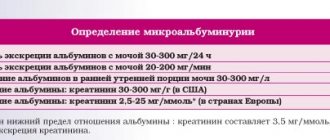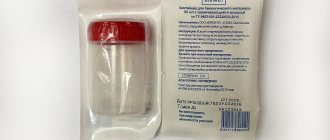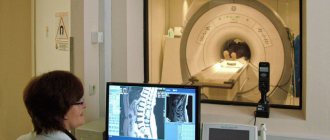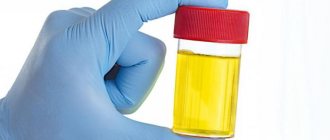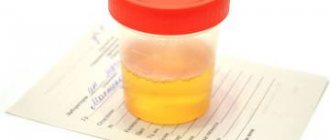General information
The biofluid produced and excreted by the kidneys contains various organic and inorganic substances. They have the ability to actively interact with the environment. Light, air, and changes in temperature cause a transformation in the biochemical composition and physical properties of urine, which can make it completely unsuitable for research.
If urine has been stored for a long time before being sent to the laboratory, pathogenic microorganisms will be found in it. In addition, ammonia is formed in urine, acidity changes, the sediment necessary for research disintegrates, and bile pigments are destroyed. The optimal shelf life for an adult test is considered to be two hours from the moment of collection of the biofluid.
The urine of infants must be delivered to the laboratory as quickly as possible, since the rate of ammonia formation in children's urine is several times higher. Modern clinical microscopy has several methods for studying the composition and properties of biomaterials. How to collect urine correctly and how long you can store urine depends on the type of test ordered.
The following types of tests are most often prescribed:
- General urine analysis. Designed to determine basic characteristics (color, smell, acidity, presence of blood cells, protein, sugar, etc.).
- Test according to Nechiporenko. Allows you to assess the health of the kidneys and urinary tract. It is prescribed to confirm (refute) the alleged diagnosis in case of unsatisfactory results of the general analysis.
- Zimnitsky test. It is the basis for diagnosing kidney and heart diseases.
- Daily diuresis. Serves to detect glucose and pathologies of the renal apparatus.
- Three-glass sample. Gives an idea of the health of the urinary organs.
Analysis according to Zimnitsky and daily diuresis are suitable for research for no more than twenty-four hours, subject to storage conditions.
Collection and storage of urine for general analysis and Nechiporenko test
An average portion of morning urine collected on an empty stomach is sent for examination. First, you should urinate into the toilet, then into the container, and then back into the toilet. To conduct a general analysis, you need about 75 ml of biomaterial; for the Nechiporenko test, 30–40 ml is enough.
The container intended for study using the general clinical method and the Nechiporenko method must be delivered to the laboratory within two hours. Is it possible to store collected biomaterial in the refrigerator? For general analysis, this method is extremely undesirable. The Nechiporenko sample is not subject to cooling. Otherwise, the results will not be reliable.
How long is urine stored for analysis? Are there any differences depending on the type?
If urine collected for analysis is stored for more than a day, then it is no longer suitable for research and it does not matter where it was all this time. To obtain reliable information on the urine formula and changes in it, you must strictly follow the rules for collecting and storing biological material.
| Type of analysis for which urine is collected | Terms and conditions of storage |
| General analysis | It is collected in the morning on an empty stomach and cannot be stored. When delivering the material to the laboratory, you need to control it so that it does not get too cold. |
| According to Zimnitsky | Urine is collected 8 times a day, the container with it is stored in a cold place, but exactly 24 hours later the material is sent to the laboratory. |
| According to Nechiporenko | Can be stored for a maximum of 1 hour from the moment of collection. |
| Daily urine (Kakovsky-Addis method) | Urine is collected throughout the day, and the container with it is stored in the refrigerator all the time. |
| Three-glass sample | The material is collected in the morning after a 5-hour abstinence; it cannot be stored - it must be delivered to the laboratory within a maximum of 1 hour. |
General analysis
This type of laboratory study of urine involves determining the visual properties, chemical composition and studying the sediment. It is required to submit an average portion of morning urine; absolutely accurate results can only be obtained if fresh material is submitted, so it cannot be stored.
In some cases, it is allowed to save urine for general analysis for 2 hours, but only in a cool place, avoiding severe hypothermia.
Daily urine
This analysis has a second name according to the Kakovsky-Addis method, is prescribed by doctors extremely rarely and is required only for diagnosing dangerous pathologies of the genitourinary system. Urine is collected in a three-liter jar for 24 hours. All this time, the dishes should be in a cool place, and if it is a refrigerator, then control should be made to ensure that the material does not freeze.
To preserve the urine formula, you can add a few drops of formaldehyde to the container, but in this case the urine will change color and become cloudy. No more than 100 ml of daily urine will need to be delivered to the laboratory.
According to Zimnitsky
The material collected for this study is needed to determine the level of functionality of the entire renal apparatus. Urine collection takes place within 24 hours in 8 sterile containers, each of which must be numbered. They are stored in the refrigerator; all material must be submitted one day after the start of urine collection.
According to Nechiporenko
Urinalysis according to Nechiporenko is done to diagnose pyelonephritis and cystitis. You can store urine collected for such a study for no more than 1 hour - later bacteria in the material will begin to multiply, which will distort the results. Biological material must be delivered to the laboratory almost immediately after collection.
Three-glass sample
Urine is collected in one void and distributed into three containers. The material is stored at room temperature for no more than 2 hours, after which the test results can be radically distorted. In some cases, urine can be stored for 24 hours, but only in a cool place - the optimal temperature should not exceed 5 C.
Zimnitsky sample, collection and storage procedure
The peculiarity of this method is the study of eight urine samples, which the patient collects in different containers throughout the day. Mixing biomaterial is strictly prohibited. For a qualitative analysis, you must perform the following steps:
- purchase pharmacy containers;
- collect urine strictly on time, starting from 9:00 am (during the period from 6:00 to 9:00 urine is not collected);
- every three hours (including night time), fill a separate container, the last portion is taken the next morning from 6 to 9 o’clock;
- be sure to sign the containers (last name, time);
- On a separate form, record the amount of liquid drunk, and the liquid contents of dishes (broth), the time interval of urination, the amount of urine excreted.
If there is no desire to empty the bladder at the specified time, an empty container is sent to the laboratory. If you want to urinate several times within three hours, all urine excreted is collected (if necessary, in an additional container).
All filled containers are stored only in the refrigerator. It is prohibited to freeze biomaterial. The ideal temperature is +4–6℃. It is recommended to discuss storage conditions with your doctor in advance. In some cases, the use of preservatives (boric acid, acetic acid, thymol) is allowed. Your doctor should tell you more about their use.
Example of analysis according to Zimnitsky
Is it possible to store urine for longer than the specified time?
Freshly collected urine is the best option for analysis, but it is not always possible to correctly collect and store it. Tests are often prescribed for children, infants, and patients who have serious problems with urination.
The work schedule also makes its own temporary adjustments. In these cases, it is worth remembering that the container with urine can be kept in the refrigerator for a certain time. There it should only cool down a little, but not start to freeze. The optimal temperature to preserve the properties of the material is +4 degrees. Such conditions in the refrigerator are created on the doors or on the shelf at the very bottom of the chamber.
Important! If the urine has been stored in the refrigerator since the evening, this point should be indicated to the laboratory assistant.
In some cases, to determine the full picture of the disease, patients need to collect all their urine per day. In this case, there is no way to do without storing it for more than 2 hours. Special preservatives will help preserve the properties of urine.
The following substances can be added:
- Acetic acid (glacial). No more than 5 ml of liquid for the entire volume of urine collected per day.
- Toluene. Use no more than 2 ml for the entire container. Such a substance can lead to sediment after several hours.
- Boric acid. Add in the following doses: for every 100 ml, 3 granules.
- Thymol. Use 2 crystals per 100 ml volume of urine.
Daily diuresis
Daily urine is collected in one three-liter container, prepared independently (sterilized and dried). An alternative could be a large medicine container with a capacity of 2.7 liters. The first morning portion of urine is not subject to collection.
The countdown begins with the second emptying of the bladder. The results of all urinations are drained into a container.
Collected urine should be stored exclusively in the refrigerator, without freezing. A mandatory condition for safety is a sealed lid on the container with biomaterial.
After 24 hours, the biofluid must be mixed, the resulting volume measured and recorded. From the total amount, separate a portion of urine, placed in a standard (small) sterile container, and immediately deliver it to the study site.
Three-glass sample
To carry out the analysis, you need to purchase three containers and number them. During the first morning emptying of the bladder, you need to urinate into each container (the portion calculation is: 25% of the volume of urine in the first and third containers, and 50% in the second).
It is strictly forbidden to transfer biological fluid from one container to another. How long is urine stored for analysis of a three-glass sample? The biomaterial is valid for microscopy only if it is stored for no more than 60 minutes at room temperature.
How to properly collect a baby for analysis
An example of how to use a urine collector for an infant
To analyze urine from an infant, you need to collect 100-150 ml of material, and this is not difficult for adults, but in infancy it can become a real problem. A special urinal, which is a small polyethylene container with a hole and Velcro, will help solve it. The urine collector is attached to the baby; there is no need to put a diaper under it - the device will simply come off. After collecting the required amount of urine, it is poured into a container.
It is strictly forbidden to collect urine in a pot, since even after thorough washing with cleaning agents/detergents, this item may cause unreliable results. Urine is suitable for analysis in a child for a maximum of 2 hours, not counting specific studies when the study of daily material is required.
Features of the collection and storage of children's urine
For proper collection of urine from an infant, special urinals are provided (for boys, for girls and universal). Using adhesive fasteners, the pediatric urinal is fixed between the baby's legs. You can carefully carry out the procedure before the baby wakes up. After morning urination, the biofluid is transferred to a pharmaceutical container.
In older boys, urine collection for the Nechiporenko test is carried out using a pot. The child needs to urinate into the potty, then into a sterile container and then finally empty the bladder into the potty. For girls of preschool age, it is recommended to place a wide plate under their bottom, previously washed without disinfectant detergents and dried from moisture. Urine from the plate should be poured into a medicine container.
Important! Urine from a baby's diaper is not suitable for research. Hygienic material is not sterile and may contain microorganisms. The results of the analysis in this case will not be objective.
Is it possible to collect a urine test in the evening? No you can not. Children's urine is extremely sensitive to external influences, so only a fresh sample is suitable for high-quality microscopy. The collected biomaterial is valid for research for two hours. Delivery of the container to the laboratory should be done as quickly as possible.
Algorithm for using a pediatric urinal bag
Where and how to store urine before submitting it to the laboratory
Before submitting to the laboratory, you need to store urine only in sterile containers; it is advisable to purchase special plastic containers for this. After collecting the material, you need to close the container with a lid, put it in a bag and in a second larger container - this will prevent accidental leakage of urine and “seal” its smell.
Urine is stored at a temperature of 2-4 C for a maximum of 24 hours - the exact timing depends on the specific type of study to be performed. It is necessary to protect the container with the material from direct sunlight and bright light.
In a refrigerator
From a temperature point of view, the refrigerator is an ideal place to store urine. It is not recommended to place the container with the material on the door, because each time it is opened, the temperature in this area will increase significantly, which can distort the urine formula.
The optimal place in the refrigerator is the central shelf. Here the urine can be stored in accordance with the possible time frames for each analysis individually.
At room temperature
It is extremely undesirable to leave urine at room temperature for more than 1 hour - exceeding the storage temperature leads to changes in chemical parameters, a precipitate may form - it will not be possible to obtain reliable research results.
Is it possible to collect it in the evening?
The maximum shelf life of urine for most laboratory tests is 2 hours, so there is no point in collecting material in the evening - the results will be completely distorted.
Is it allowed in a glass jar
It is allowed to collect urine for analysis in a glass jar, but only if it is first sterilized. The lid that will close the container must also be sterile.
Many laboratories simply do not accept urine in glass jars, so it is advisable to use special plastic containers, which are sold in pharmacies at low cost.
Preparation for general and daily analysis, Nechiporenko test
The objectivity of the research results largely depends on preliminary preparation. Before the analysis, the patient must:
- stop taking medications and multivitamins (women need to give up vaginal contraceptives, douching, medicinal vaginal suppositories);
- within a couple of days, eliminate fatty foods from the diet, foods that tend to color urine (beets, asparagus, carrots, rhubarb, blackberries), and eliminate the consumption of alcoholic beverages;
- limit the intensity of sports training and other physical activity (2-3 days before the test);
- avoid hypothermia;
- Purchase a sealed, sterile container for collecting urine at the pharmacy.
Immediately before collecting urine, it is necessary to carry out a hygiene procedure for the external genitalia (without using perfumed body products). The limitation for donating urine is the period of menstrual flow in women. If possible, the study should be rescheduled.
If urgent analysis is necessary, it is recommended to use a hygienic tampon so that blood secretions cannot get into the urine. There is no special preparation for the Zimnitsky test. The patient is advised not to exceed the daily fluid intake and avoid diuretic medications.
How to properly prepare before taking the test
Many people do not know how, where and whether it is even possible to store urine before taking an analysis. There are certain recommendations, following which will help you collect urine correctly and get the correct research result.
One day before the due date you cannot:
- drinking alcohol,
- eat apples and carrots,
- take medications that can affect the composition of urine,
- use diuretics.
Before taking tests, you need to do hygiene procedures. Only then should you begin collecting material.
If it is necessary to undergo a general analysis, then the liquid is taken from the “middle stream”, i.e. start and finish urinating in the toilet, and the urine from the middle of urination is collected in a special container.
Results
There are several types of assessment of the biochemical composition and physical properties of urine. The necessary analysis is prescribed by the doctor depending on the suspected disease. To obtain accurate research results, you must comply with:
- mandatory genital hygiene before urination:
- conditions for urine collection determined by the type of analysis;
- rules for storing biomaterial at home and its delivery to the laboratory.
Urine collected in a sterile container and stored for no more than 2 hours is allowed to be submitted for examination. Under the influence of light, high or low temperature, or contact with air, urine changes its qualities, which distorts the final results of microscopy. This is especially true for the overly sensitive urine of young children.
When carrying out special tests (Zimnitsky test and three-glass test), urine can be preserved by cooling. Freezing biofluid samples is strictly prohibited. The accuracy of the results directly depends on the patient’s conscientious attitude towards the rules for collecting and storing the biofluid intended for analysis.
How to collect and store urine from newborns
The urine of a child under 1 year of age has the property of rapid oxidation, so storing organic liquid of newborns is not recommended.
Basic methods of taking samples from infants:
- Using a regular package;
- Using a special urinal;
- Any sterile container.
It is not recommended to leave an infant’s organic matter in a jar for more than 120 minutes before transferring it to the laboratory. Organic samples from the newborn should be kept in a sterile container or tube with a tightly closed lid.

